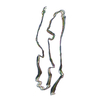[English] 日本語
 Yorodumi
Yorodumi- PDB-8ttn: PHF1-Phosphomimetic Tau Filaments (Full-length, Cofactor-Free 0N4... -
+ Open data
Open data
- Basic information
Basic information
| Entry | Database: PDB / ID: 8ttn | ||||||||||||
|---|---|---|---|---|---|---|---|---|---|---|---|---|---|
| Title | PHF1-Phosphomimetic Tau Filaments (Full-length, Cofactor-Free 0N4R Tau S396E, S400E, T403E, S404E) | ||||||||||||
 Components Components | Microtubule-associated protein tau | ||||||||||||
 Keywords Keywords | PROTEIN FIBRIL / Tau / Amyloid Fibril / Phosphomimetic | ||||||||||||
| Function / homology |  Function and homology information Function and homology informationplus-end-directed organelle transport along microtubule / histone-dependent DNA binding / negative regulation of establishment of protein localization to mitochondrion / neurofibrillary tangle / microtubule lateral binding / axonal transport / main axon / phosphatidylinositol bisphosphate binding / regulation of long-term synaptic depression / tubulin complex ...plus-end-directed organelle transport along microtubule / histone-dependent DNA binding / negative regulation of establishment of protein localization to mitochondrion / neurofibrillary tangle / microtubule lateral binding / axonal transport / main axon / phosphatidylinositol bisphosphate binding / regulation of long-term synaptic depression / tubulin complex / positive regulation of protein localization to synapse / negative regulation of tubulin deacetylation / generation of neurons / regulation of chromosome organization / rRNA metabolic process / axonal transport of mitochondrion / regulation of mitochondrial fission / axon development / central nervous system neuron development / intracellular distribution of mitochondria / regulation of microtubule polymerization / microtubule polymerization / lipoprotein particle binding / minor groove of adenine-thymine-rich DNA binding / dynactin binding / negative regulation of mitochondrial membrane potential / apolipoprotein binding / axolemma / protein polymerization / glial cell projection / negative regulation of mitochondrial fission / Caspase-mediated cleavage of cytoskeletal proteins / regulation of microtubule polymerization or depolymerization / positive regulation of axon extension / neurofibrillary tangle assembly / Activation of AMPK downstream of NMDARs / regulation of cellular response to heat / synapse assembly / supramolecular fiber organization / positive regulation of protein localization / regulation of calcium-mediated signaling / somatodendritic compartment / cellular response to brain-derived neurotrophic factor stimulus / cytoplasmic microtubule organization / positive regulation of microtubule polymerization / axon cytoplasm / stress granule assembly / phosphatidylinositol binding / regulation of microtubule cytoskeleton organization / nuclear periphery / protein phosphatase 2A binding / positive regulation of superoxide anion generation / cellular response to reactive oxygen species / astrocyte activation / Hsp90 protein binding / microglial cell activation / cellular response to nerve growth factor stimulus / response to lead ion / synapse organization / PKR-mediated signaling / protein homooligomerization / regulation of synaptic plasticity / SH3 domain binding / memory / microtubule cytoskeleton organization / cytoplasmic ribonucleoprotein granule / neuron projection development / cell-cell signaling / single-stranded DNA binding / protein-folding chaperone binding / actin binding / cellular response to heat / microtubule cytoskeleton / cell body / growth cone / double-stranded DNA binding / microtubule binding / protein-macromolecule adaptor activity / dendritic spine / sequence-specific DNA binding / amyloid fibril formation / microtubule / learning or memory / neuron projection / regulation of autophagy / membrane raft / axon / negative regulation of gene expression / neuronal cell body / dendrite / DNA damage response / protein kinase binding / enzyme binding / mitochondrion / DNA binding / RNA binding / extracellular region / identical protein binding / nucleus / plasma membrane Similarity search - Function | ||||||||||||
| Biological species |  Homo sapiens (human) Homo sapiens (human) | ||||||||||||
| Method | ELECTRON MICROSCOPY / helical reconstruction / cryo EM / Resolution: 2.4 Å | ||||||||||||
 Authors Authors | El Mammeri, N. / Dregni, A.J. / Duan, P. / Hong, M. | ||||||||||||
| Funding support |  United States, 3items United States, 3items
| ||||||||||||
 Citation Citation |  Journal: Proc Natl Acad Sci U S A / Year: 2024 Journal: Proc Natl Acad Sci U S A / Year: 2024Title: Structures of AT8 and PHF1 phosphomimetic tau: Insights into the posttranslational modification code of tau aggregation. Authors: Nadia El Mammeri / Aurelio J Dregni / Pu Duan / Mei Hong /  Abstract: The microtubule-associated protein tau aggregates into amyloid fibrils in Alzheimer's disease and other neurodegenerative diseases. In these tauopathies, tau is hyperphosphorylated, suggesting that ...The microtubule-associated protein tau aggregates into amyloid fibrils in Alzheimer's disease and other neurodegenerative diseases. In these tauopathies, tau is hyperphosphorylated, suggesting that this posttranslational modification (PTM) may induce tau aggregation. Tau is also phosphorylated in normal developing brains. To investigate how tau phosphorylation induces amyloid fibrils, here we report the atomic structures of two phosphomimetic full-length tau fibrils assembled without anionic cofactors. We mutated key Ser and Thr residues to Glu in two regions of the protein. One construct contains three Glu mutations at the epitope of the anti-phospho-tau antibody AT8 (AT8-3E tau), whereas the other construct contains four Glu mutations at the epitope of the antibody PHF1 (PHF1-4E tau). Solid-state NMR data show that both phosphomimetic tau mutants form homogeneous fibrils with a single set of chemical shifts. The AT8-3E tau rigid core extends from the R3 repeat to the C terminus, whereas the PHF1-4E tau rigid core spans R2, R3, and R4 repeats. Cryoelectron microscopy data show that AT8-3E tau forms a triangular multi-layered core, whereas PHF1-4E tau forms a triple-stranded core. Interestingly, a construct combining all seven Glu mutations exhibits the same conformation as PHF1-4E tau. Scalar-coupled NMR data additionally reveal the dynamics and shape of the fuzzy coat surrounding the rigid cores. These results demonstrate that specific PTMs induce structurally specific tau aggregates, and the phosphorylation code of tau contains redundancy. | ||||||||||||
| History |
|
- Structure visualization
Structure visualization
| Structure viewer | Molecule:  Molmil Molmil Jmol/JSmol Jmol/JSmol |
|---|
- Downloads & links
Downloads & links
- Download
Download
| PDBx/mmCIF format |  8ttn.cif.gz 8ttn.cif.gz | 171.6 KB | Display |  PDBx/mmCIF format PDBx/mmCIF format |
|---|---|---|---|---|
| PDB format |  pdb8ttn.ent.gz pdb8ttn.ent.gz | 124.3 KB | Display |  PDB format PDB format |
| PDBx/mmJSON format |  8ttn.json.gz 8ttn.json.gz | Tree view |  PDBx/mmJSON format PDBx/mmJSON format | |
| Others |  Other downloads Other downloads |
-Validation report
| Summary document |  8ttn_validation.pdf.gz 8ttn_validation.pdf.gz | 1.1 MB | Display |  wwPDB validaton report wwPDB validaton report |
|---|---|---|---|---|
| Full document |  8ttn_full_validation.pdf.gz 8ttn_full_validation.pdf.gz | 1.1 MB | Display | |
| Data in XML |  8ttn_validation.xml.gz 8ttn_validation.xml.gz | 36.1 KB | Display | |
| Data in CIF |  8ttn_validation.cif.gz 8ttn_validation.cif.gz | 50.7 KB | Display | |
| Arichive directory |  https://data.pdbj.org/pub/pdb/validation_reports/tt/8ttn https://data.pdbj.org/pub/pdb/validation_reports/tt/8ttn ftp://data.pdbj.org/pub/pdb/validation_reports/tt/8ttn ftp://data.pdbj.org/pub/pdb/validation_reports/tt/8ttn | HTTPS FTP |
-Related structure data
| Related structure data |  41611MC  8ttlC M: map data used to model this data C: citing same article ( |
|---|---|
| Similar structure data | Similarity search - Function & homology  F&H Search F&H Search |
- Links
Links
- Assembly
Assembly
| Deposited unit | 
|
|---|---|
| 1 |
|
- Components
Components
| #1: Protein | Mass: 40227.973 Da / Num. of mol.: 5 / Mutation: S396E, S400E, T403E, S404E Source method: isolated from a genetically manipulated source Details: Using Numbering from 2N4R Tau / Source: (gene. exp.)  Homo sapiens (human) / Gene: MAPT, MAPTL, MTBT1, TAU / Production host: Homo sapiens (human) / Gene: MAPT, MAPTL, MTBT1, TAU / Production host:  |
|---|
-Experimental details
-Experiment
| Experiment | Method: ELECTRON MICROSCOPY |
|---|---|
| EM experiment | Aggregation state: FILAMENT / 3D reconstruction method: helical reconstruction |
- Sample preparation
Sample preparation
| Component | Name: PHF1-Phosphomimetic 0N4R Tau Fibrils / Type: COMPLEX / Entity ID: all / Source: RECOMBINANT | ||||||||||||||||||||
|---|---|---|---|---|---|---|---|---|---|---|---|---|---|---|---|---|---|---|---|---|---|
| Molecular weight | Experimental value: NO | ||||||||||||||||||||
| Source (natural) | Organism:  Homo sapiens (human) Homo sapiens (human) | ||||||||||||||||||||
| Source (recombinant) | Organism:  | ||||||||||||||||||||
| Buffer solution | pH: 6.8 Details: 50 mM K2HPO4 buffer, pH 6.8, containing 300 mM NaCl, 5 mM DTT, and 1x cOmplete protease inhibitor cocktail tablet (Roche) per 40 ml fibrillization buffer. | ||||||||||||||||||||
| Buffer component |
| ||||||||||||||||||||
| Specimen | Conc.: 1.6 mg/ml / Embedding applied: NO / Shadowing applied: NO / Staining applied: NO / Vitrification applied: YES | ||||||||||||||||||||
| Specimen support | Grid material: GOLD / Grid mesh size: 400 divisions/in. / Grid type: Quantifoil R1.2/1.3 | ||||||||||||||||||||
| Vitrification | Instrument: FEI VITROBOT MARK IV / Cryogen name: ETHANE / Humidity: 95 % / Chamber temperature: 277 K |
- Electron microscopy imaging
Electron microscopy imaging
| Experimental equipment |  Model: Titan Krios / Image courtesy: FEI Company |
|---|---|
| Microscopy | Model: TFS KRIOS |
| Electron gun | Electron source:  FIELD EMISSION GUN / Accelerating voltage: 300 kV / Illumination mode: SPOT SCAN FIELD EMISSION GUN / Accelerating voltage: 300 kV / Illumination mode: SPOT SCAN |
| Electron lens | Mode: BRIGHT FIELD / Nominal defocus max: 2000 nm / Nominal defocus min: 400 nm |
| Image recording | Electron dose: 50.7 e/Å2 / Film or detector model: GATAN K3 BIOQUANTUM (6k x 4k) |
- Processing
Processing
| EM software |
| ||||||||||||||||||||
|---|---|---|---|---|---|---|---|---|---|---|---|---|---|---|---|---|---|---|---|---|---|
| CTF correction | Type: PHASE FLIPPING AND AMPLITUDE CORRECTION | ||||||||||||||||||||
| Helical symmerty | Angular rotation/subunit: -1.07 ° / Axial rise/subunit: 4.79 Å / Axial symmetry: C1 | ||||||||||||||||||||
| Particle selection | Num. of particles selected: 3830683 / Details: Manual Selection of Start-End Coordinates | ||||||||||||||||||||
| 3D reconstruction | Resolution: 2.4 Å / Resolution method: FSC 0.143 CUT-OFF / Num. of particles: 132972 / Symmetry type: HELICAL |
 Movie
Movie Controller
Controller



 PDBj
PDBj





